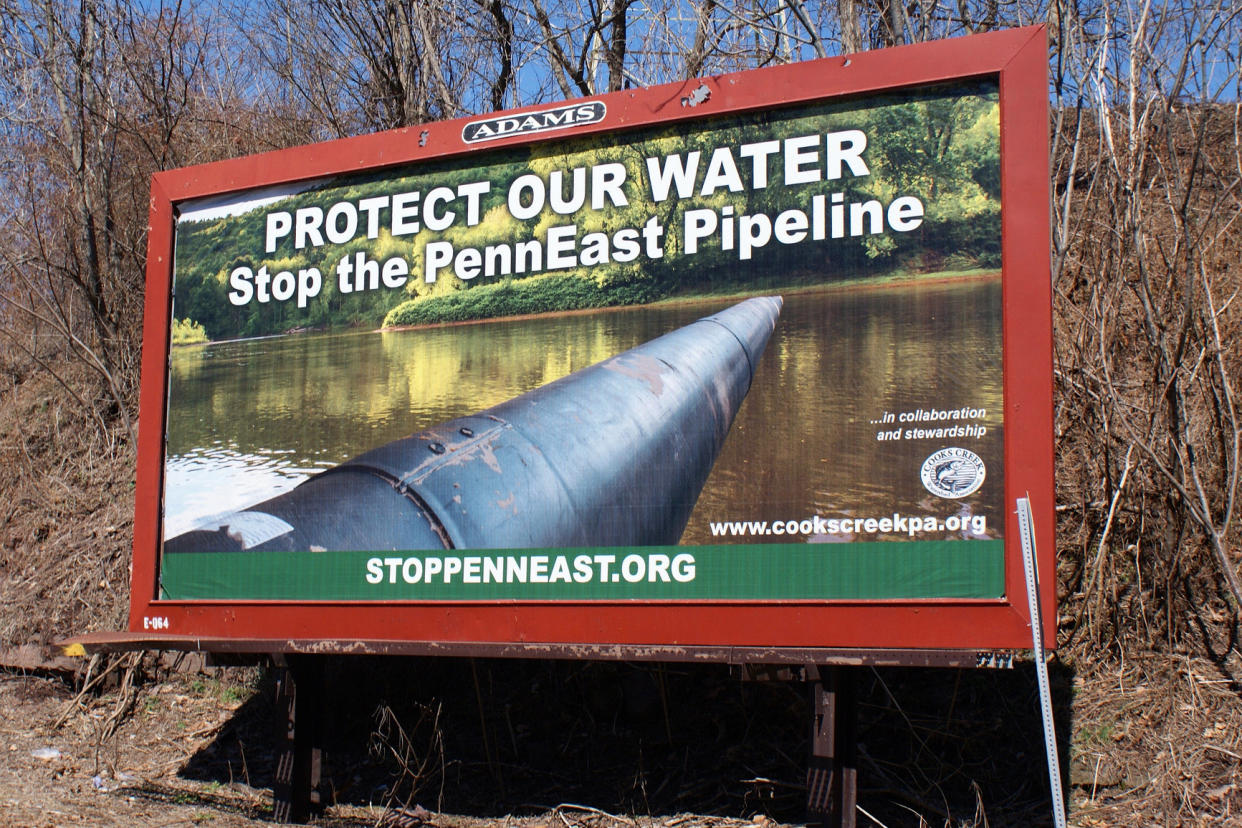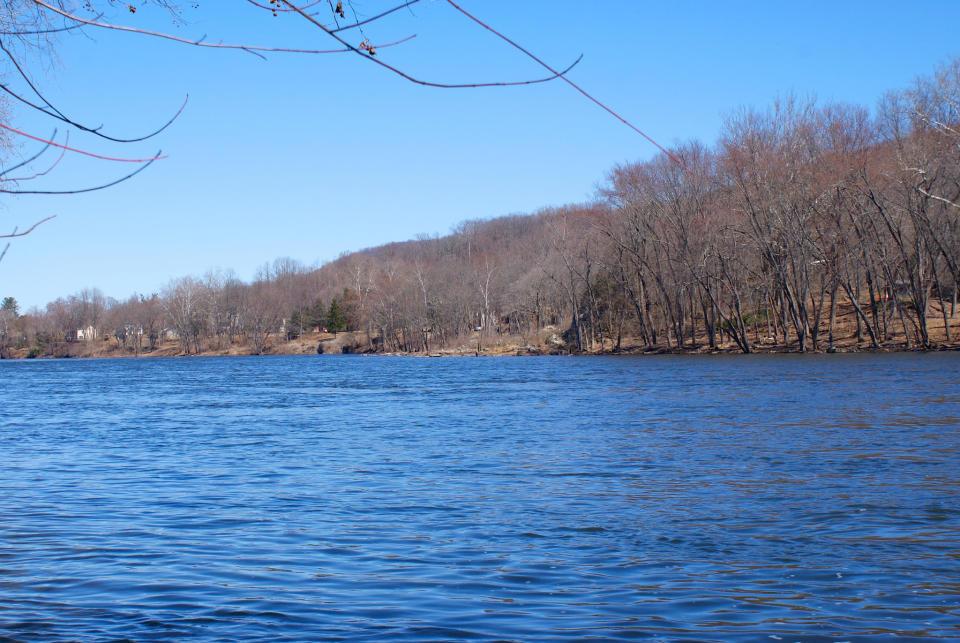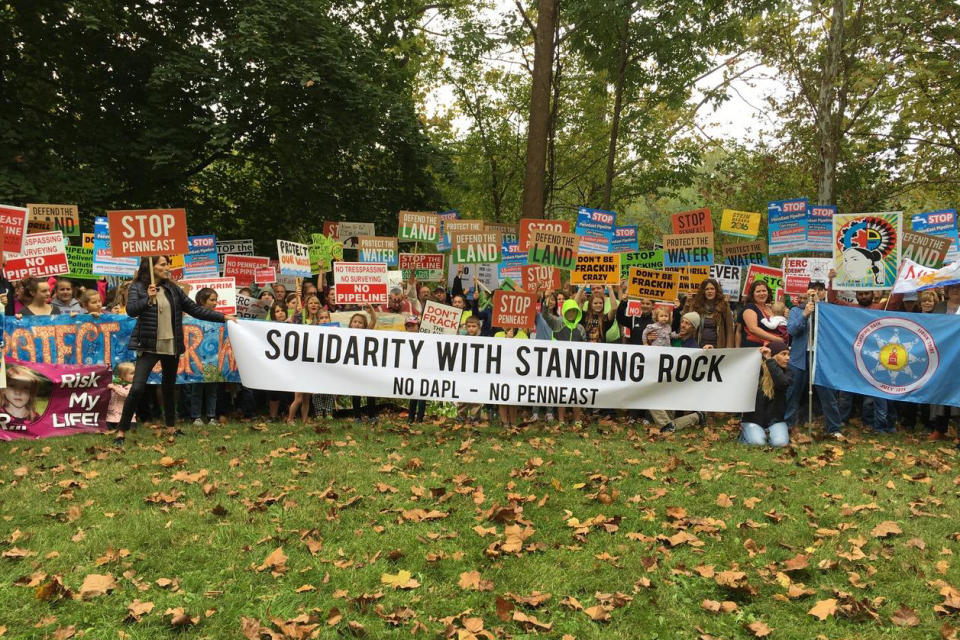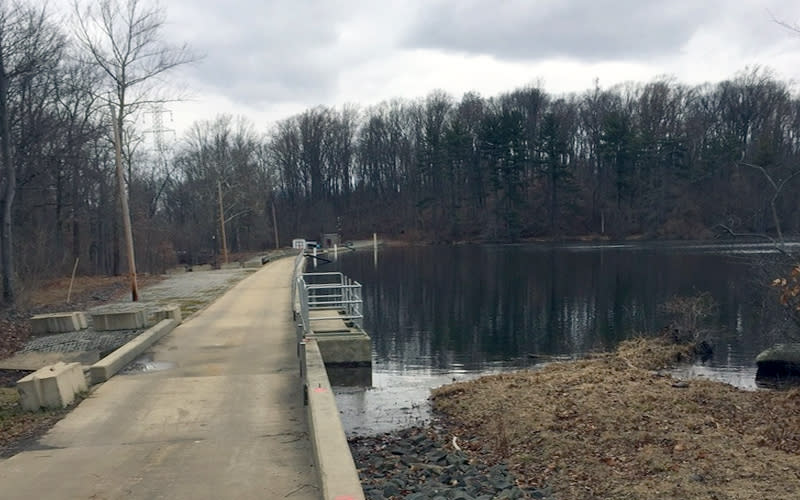Does New Jersey need the PennEast pipeline? To the companies that want to build it, that’s the wrong question.

Jacqueline Evans is a single mother with three young children living on the certified organic farm her family built in rural New Jersey. She keeps sheep, goats, chickens, ducks and honeybees.
A proposed pipeline that’s upended her community would go right past her front door in the bucolic town of Stockton, N.J. She fears it would destroy her farmland, ruin her property value and place her children in “an incineration zone” — that is, if the natural gas in the pipeline catches fire and explodes.
Evans accuses the PennEast Pipeline Company’s surveyors of trespassing on her property and harassing her family. She thinks the company’s plan to invoke “eminent domain for corporate gain” is un-American.
“They are so aggressive, so mean. They show no respect at all. They’re intimidating,” Evans told Yahoo News. “Your home is supposed to be some place you feel safe, and they take that away.”
Vince DiBianca, who lives on a farm in Delaware Township, N.J., is frustrated that the pipeline will come right by his driveway, but he’s just as concerned for his neighbors.
Many homeowners who would be affected by the proposed pipeline route — including DiBianca and Evans — have banded together to form HALT PennEast, which stands for Homeowners Against Land Taking. They’re well organized and vocal.
“It’s disturbing and will permanently scar one of the most environmentally, culturally and historically sensitive areas in the region. Why would they possibly do this?” DiBianca said.

Would you believe it’s for the money? The roughly 120-mile-long pipeline linking the state to gas fields in Pennsylvania isn’t necessary for New Jersey to meet its energy needs, even during peak demand, as the company admits in legal documents. Instead, the companies behind the pipeline stand to profit from building it, whether it’s needed or not.
Tom Gilbert is the campaign director for energy, climate and natural resources at the New Jersey Conservation Foundation and ReThink Energy NJ, which have been fighting to preserve farmland on their side of the Delaware River for three decades.
“There’s a lot of compelling evidence from credible sources that there’s no need for it,” Gilbert said. “It’s one thing to have all these impacts if the project is truly in the public’s interests and there’s some legitimate public need for the gas. But several experts have concluded that’s just not the case on this project”
“This isn’t a hospital or a needed highway,” Evans said. “It’s unbelievable.”
The New Jersey Division of Rate Counsel (NJDRC), the independent consumer utility watchdog, conducted an analysis that found no need for the project and concluded it would be unfair to ratepayers. NJDRC reports that New Jersey gets more than 100 percent of the gas it needs from existing pipelines.
“This is not something that New Jersey Rates Counsel has ever said before about any other pipeline — and there are numerous proposals in the state — so it’s a pretty damning position that this agency took in terms of what’s really driving this project,” Gilbert said.
According to the NJDRC report, the return on investment the companies would receive would be “like winning the lottery for the company.”
Energy companies stand to profit from owning the pipeline rather than relying on the legacy pipelines from which they already get their gas. The companies involved in PennEast — New Jersey Resources, South Jersey Industries, Southern Company Gas, Spectra Energy Partners and the UGI Corporation — would be both owners and customers of the pipeline, meaning they would essentially be selling to themselves.

Mike Spille, whose home abuts the proposed pipeline route in West Amwell, N.J., said the primary buyers of gas from the pipeline are subsidiaries of those very companies. He said PennEast admits in its FERC filings that the pipeline is being built not to meet demand but because they plan on letting their contracts with existing pipelines lapse.
“Currently, there’s a tariff on the money that they pay the pipeline companies that’s going out the door. With PennEast, they’re basically paying the money back to themselves so they have a new revenue stream,” Spille said. “That’s the real reason they’re doing it — to get a growth strategy for Wall Street. They’re not doing it to help the region at all.”
Michael Heffler, of Lambertville, N.J., is also a member of HALT PennEast. He said he’s not opposed to businesses making money when they provide a service to the community. But he takes issue with companies that push through unnecessary and harmful projects solely to make money.
“I don’t mind profits. What I mind is profits with no value. We don’t need the gas. We’ve got over 100 percent of the gas we need. If you’re getting a profit, you should get value. They’re providing no value,” Heffler said. “It’s actually worse than them being greedy. They’re immoral and unethical.”
“It’s a pretty smart move from a corporate perspective,” DiBianca said. “It’s an incredibly damaging move from a community, environmental and homeowner perspective.”
Patricia Kornick, the project spokesperson for the PennEast Pipeline, argued that there are many reasons to construct a pipeline other than meeting peak demand: cost savings, supply security, supply diversity and reliability.
“Objective observers can understand how accessing one of the most abundant and affordable supplies of natural gas in all of North America — rather than paying 34 percent more for gas transported over 1,000 miles from the Gulf Coast only to return to the Northeastern market from which it originated — enhances reliability, increases supply security and lowers consumer utility costs,” Kornick said.

According to Kornick, PennEast evaluated approximately 100 route variations to minimize environmental impact, and the route it chose is largely based on input from landowners, public officials and agencies.
The New Jersey Department of Environmental Protection (DEP) rejected PennEast Pipeline’s application for water permits on June 28. The DEP told PennEast that its application did not provide enough information to properly evaluate land use permits.
On April 26, DEP told PennEast that it had 30 days to submit additional information about issues with its application — otherwise it would be deemed incomplete and “administratively closed.”
The company was not able to provide information for two-thirds of its proposed route — through farmland, preserved space and private property — because people have denied it access.
Critics celebrated this denial as a major setback for PennEast, which needs the water and wetland permits to start construction.
“DEP did its job and saw through PennEast’s con-game. Under the rules, they had to reject this application because PennEast is missing so much information and was a sham,” Jeff Tittel, the director of the New Jersey Sierra Club, said in a statement. “We are glad DEP denied this worthless permit application.”
According to Kornick, however, this administrative rejection was “not unexpected” and is only a “temporary action.”
The Federal Energy Regulatory Commission (FERC), an independent agency that regulates the transmission of electricity and natural gas, is reviewing the PennEast Pipeline project. FERC issued a final environmental impact statement in early April and concluded that there will be harm to the environment but that it could be mitigated.

“Based on that final, favorable environmental impact statement, PennEast does anticipate receiving a certificate of public convenience and necessity approving the project,” Kornick said. “PennEast remains on track to receive a final project approval late this summer. Following federal approval, PennEast will simply resubmit its permit application to the New Jersey DEP.”
The proposed gas pipeline would start in Dallas, Luzerne County, in northeastern Pennsylvania, where there’s fracking of the Marcellus Shale wells. Then it would traverse the Lehigh Valley and northern Bucks County before crossing the Delaware River into New Jersey, where it would essentially run parallel to the river through Hunterdon and Mercer counties. It would terminate at Transco’s pipeline interconnection near Pennington.
“There’s a lot at stake here. It really would cut through an incredibly beautiful, historic, environmentally significant area,” Gilbert said. “When we learned about this proposal that would cut through an area where there’s over 4,000 acres of land that’s been preserved, we felt we had to come to the defense of those lands.”
Environmentalists generally worry that natural gas pipelines will further lock the region into reliance on fossil fuel at a time when the international community is trying to move toward renewable energy. But there are even more immediate concerns.
Many residents were worried that pipeline construction in the region’s arsenic-rich bedrock could lead to water contamination.
Tullis Onstott, a professor of geosciences at the University of Princeton, said the design of the pipeline would result in a maximum impact on groundwater contamination if anything untoward happened during its construction or operation.

He is concerned that the pipeline would be particularly damaging because of two underlying factors of the region’s geology: high levels of arsenic and uranium, and the low porosity of the rocks.
“That means if you mobilize even a small fraction of arsenic that’s in that rock into the water, it gets concentrated very quickly at high levels and migrates great distances,” Onstott told Yahoo News. “It’s that combination of the geology and the hydrology that makes it the worst possible site to put this in. And on top of that, they have it oriented in such a way that it maximizes the potential impact it would have. You couldn’t design it worse in that regard.”
Kornick adamantly denied that the arsenic poses a risk, saying that has “absolutely been discounted numerous times.” PennEast is promoting a study conducted from 2015 to 2016 by Michael Serfes, a former research scientist at the New Jersey DEP, who accused Onstott of being “speculative” and “alarmist.”
He argued that the construction of roadways, sewer lines, housing and commercial developments carry contain the same — if not a greater — risk of arsenic release.
“The results of my study clearly demonstrated that, during construction, although some of these freshly broken rock materials will release a relatively insignificant quantity of arsenic initially, the concentrations quickly decrease toward expected natural background levels that will have insignificant impacts to drinking water,” Serfes wrote.

Paul Boudreaux, the president of the Morris County Chamber of Commerce, testified at a FERC hearing about the pipeline last year in Clinton, N.J., on behalf of the chamber’s 930 member companies. He argued that the natural gas supply would be a boon for New Jersey’s residential and business consumers, lead to a more reliable electricity grid and put downward pressure on gas prices.
“We just look at the whole energy environment, which is fascinating right now. There are so many changes, so much new technology, and we are absolutely in favor of renewables but we don’t think they can provide the capacity we need over the next five to ten years at a minimum,” Boudreaux told Yahoo News.
PennEast has been promoting the jobs the pipeline would create, but critics say their numbers are inflated and that most of them — being construction rather than maintenance positions — would only last for the six or so months needed to construct the pipeline.
By PennEast’s own figures, the ongoing maintenance and operation of the pipeline would create only about 98 permanent jobs in New Jersey and Pennsylvania combined.
“But that’s not what they tell you. They just say thousands of jobs,” Gilbert said. “They’re not telling you that those jobs are just six months in duration. They’re not telling you that half of those jobs go to specialized workers from other states. So the picture they are painting is a lot rosier than the reality of it. And the fact that small number of jobs and those short terms jobs to not justify or outweigh the incredible environmental damage that would result, especially when there’s no evidence that there’s a real public need for this project.”
The Goodman Group evaluated the economic impact study provided by PennEast and concluded that the organization was overstating the total number of jobs — estimated at 12,160 — it would create by at least two-thirds, and that most of the jobs would be short-term in nature: namely, construction jobs lasting between six months and a year.
Despite recent setbacks, PennEast expects to receive final federal approval for the project and plans to resubmit a permit application to the NJDEP this year, Kornick said. PennEast anticipates a construction phase of roughly seven months resulting in an operational pipeline in the second half of 2018.
But the opposition isn’t backing down anytime soon.
“It’s just a mess. It threatens everything that we have,” Evans said. “And it’s the gas industry’s big push to get as much out of the ground before it’s over for them. We don’t need this. We don’t want it. They brought this fight to us.”

Read more from Yahoo News:
A Southern city struggles with the paradoxes of ‘school choice’
Senators vacate Washington, a president’s recriminations ringing in their ears
As a grand jury begins work, defiant Trump calls Russia investigation a ‘fabrication’
Murkowski, Collins reflect on bucking the GOP line on health care
Photos: ‘Just the Facts’ — Illuminating invisible lives at the 2017 LightField photo festival


